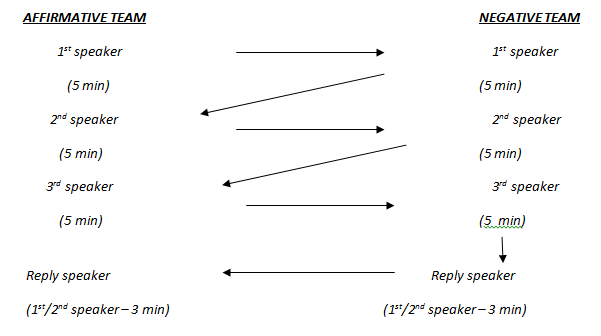What is Debate?
Debating is a clash of arguments.
Worlds
Format
- There are 2 teams debating, each consists of 3
debaters
- One team shall be the Government/Affirmative
side, the other team shall be the Opposition/Negative side
- Each speaker will deliver a substantial
speech of 5 (five) minutes in
duration, with the affirmative going first. Afterwards, either the 1st
or 2nd speaker on both sides will deliver the reply speeches
of 3 (three) minutes in duration, with the negative going first.
- Order of speaking
Motions
Motions, also known as topics, are full
propositional statements that determine what a debate shall be about.
Affirmative should argue to defend the motion, while Opposition should argue to
oppose it.
Definition
š Definitions serves the purpose to give a
clear understanding of what the motion means.
š Should not define word-by-word
š Should have a logical link to the motion
š The right to give a definition belongs to the
Government/Affirmative
š BAD definitions:
š Truistic
š Tautological
š Squirreling
š Unfair time and place setting
Definitional Challenge
š An optional strategy for the negative team when
1st govt gives BAD definition. (Only to be done when the definition
falls into that category).
š Can only be done by the 1st negative
speaker by explicitly saying “the negative team will challenge the definition”.
š What to do:
1.
Present the alternative definition. It should not fall into that criteria of
bad definition
2.
Explain why the new definition will result into a better debate
3.
(Optional) Provide an even-if case for the definition provided by the government
team.
Arguments
š Arguments
answers WHY a team supports/opposes the topic. Arguments should be logical and
relevant, backed up with reasoning and good evidence.
š Structure of the arguments:
1. Assertion – the
statement which should be proved
2. Reasoning – the
reason why that statement is logical
3. Evidence –
examples/data that support the assertion and reasoning above
4. Link Back – the
explanation of the relevance of this argument to the motion
Rebuttals
Rebuttals
are responses towards the other team’s arguments.
Rebuttals should prove that the other team’s arguments are not as
important/logical as they claim.
Speaker Roles
1st Affirmative: Prime Minister
- Give the definition of the motion
- Outline the team’s case:
š Present the team line
š Present the team split (obligatory)
- Explain the arguments that are the 1st speaker’s split
- Give a brief summary/recap of the speech
1st Negative: Leader of Opposition
- Respond to the definition
- Rebut 1st Government speaker
- Outline the team’s case:
š Present the team line
š Present the team split (obligatory)
- Explain the arguments that are the 1st speaker’s split
- Give a brief summary/recap of the speech
2nd Aff/Neg:
Deputy Prime Minister/Member of Opposition
- Signpost the structure of the speech
- Rebut the opponent’s main arguments
- Briefly restate in General the team’s case
- Explain the arguments that are the 2nd speaker’s split
- Give a brief summary/recap of the speech
3rd Aff/Neg:
Government Whip/Opposition Whip
- Signpost the structure of the speech
- Rebut opponent’s arguments, prioritizing the strong/important ones.
- Rebuild the team’s case.
- Summarize the issues of the debate within a clash.
Note:
It is not advisable for 3rd speakers
to bring new arguments
Reply Speaker (both sides)
They are both may give an overview of
the debate, especially concerning in:
• The clash point of the debate.
• What ther side has given.
• What the other side has tried to give.
• Why they should win (biased the
adjudicator)
• No rebuttal session.
• Prohibited in giving new matter.
Adjudication
• Adjudication is the process of determining which team
wins the debates. There is always a winner in a debate. There are no ‘draws’ or
‘ties’. The speakers are assessed on Matter, Manner, and Method.
Matter is 40 points, Manner is 40, and Method is 20, making a total of 100
points for each substantial speech. For reply speeches, Matter and Manner are
20 points and Method is 10, making a total of 50 points.
- Matter refers to the points,
arguments, logic, facts, statistics, and examples brought up during the
course of the debate.
- Manner is concerned with the style
of public speaking – the use of voice, language, eye contact, notes,
gesture, stance, humor and personality as a medium for making the audience
more receptive to the argument being delivered. There are no set rules,
which must be followed by debaters.
- Method consists of the effectiveness
of the structure and organization of each individual speech, the effectiveness
of the structure and organization of the team case as a whole, and the
extent to which the team reacted appropriately to the dynamics of the
debate.

0 Komentar